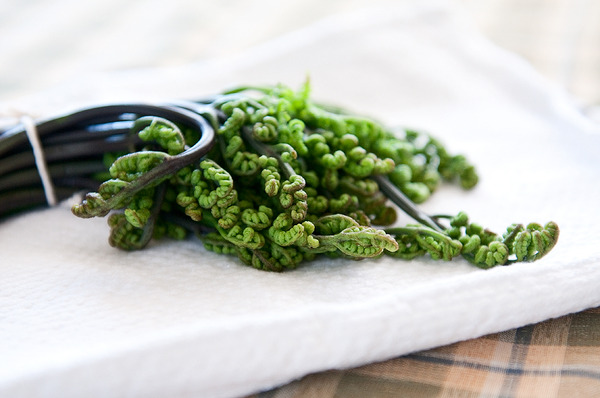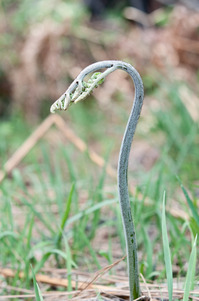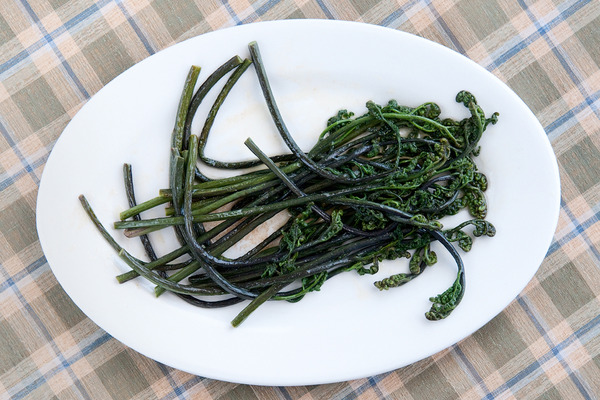The Bracken Fern: A Natural Born Killer?
Some people call this plant dinner, and others call it carcinogenic. A close look at a dangerous but widespread food.
I ate a known carcinogen this week. But then again, chances are, so did you.
Few wild plants are as polarizing as bracken fern, pteridium aquilinum. It is a global species, living everywhere but the harshest deserts and the coldest tundra. Here in California, it is ubiquitous. I find its fiddleheads—odd looking fiddleheads, like an eagle's clenched talon—in Point Reyes as early as late February. Last weekend, Holly and I found them in the high Sierra, at about 6,000 feet.
That means if you wanted, you could eat bracken fern fiddleheads for four straight months here in California. You could, but you shouldn't.
Bracken fern does indeed contains carcinogens, that much is clear. I've been spending a lot of time in the past week reading scientific papers with names like "Induction of Tumors in ACI Rats Given a Diet Containing Ptalquiloside, a Bracken Carcinogen." Breezy reading, this. But the slog has been worth it, if only because I refuse to trust the internet and my fellow foraging writers outright. Bracken is so controversial you will see them writing statements ranging from "eat it as much as you want, it's fine," to "never, ever, ever eat bracken, raw or cooked."
And like most black-and-white statements, both are wrong.
After a pretty exhaustive—and exhausting—survey of the literature, it seems pretty clear that a typical forager's diet of bracken fiddleheads, blanched and sauteed with lots of butter (or whatever) is perfectly safe. Before you start shouting at me, let me explain.
The primary villain lurking within bracken fern is a substance called ptalquiloside. It is, by all accounts, nasty stuff. And bracken fiddleheads are packed with it, up to 0.8 percent by dry weight, according to some studies. But therein lies the first caveat: A raft of other studies shows that ptalquiloside levels vary wildly in bracken stands. Some in New Zealand were even found with none of the stuff at all. So you really have no idea how much—if any—of the carcinogen lies within your pretty fiddlehead.
It is abundantly clear, however, that if you eat raw bracken fiddleheads in the woods you will probably ingest ptalquiloside. And that's not good eats.
But ptalquiloside has two properties that are of interest to us:
- First, it is water soluble. That means if you soak bracken fiddleheads in cool water (cool to keep them crunchy), and change that water every so often, you will greatly reduce the level of ptalquiloside in the fiddlehead; the Japanese often eat bracken this way.
- Second, ptalquiloside is notoriously volatile at normal temperatures. The pure stuff degenerates at room temperature, which is why the scientists doing the rat studies store their palquiloside at -20 degrees Celsius. Once exposed to boiling temperatures, the carcinogen denatures almost completely. Salt and baking soda increase this effect.
What this means is that a very normal cooking process for fiddleheads—blanching in salty water, then shocking in ice water, then sauteeing—renders the fiddlehead close to harmless.
Note that I say "close to harmless." The reason we know that bracken can cause cancer is not only because of all sorts of livestock studies—cows sometimes eat the fully grown fronds and get urinary tract cancers—but also because bracken is widely eaten in Korea, Japan and parts of China. And when I mean "widely," I mean almost every day in some cases. Bracken (gosari) is a classic part of bibimbap, one of the most famous Korean dishes there is.
Indeed, my friend and fellow forager Langdon Cook likes to eat his bracken Asian style.
Most of the research has been done by Japanese and Koreans, searching for clues as to why they seem to have high rates of throat and stomach cancer. Apparently there are a kaleidoscope of reasons, and habitual bracken-eating is among them. Like anything, ptalquiloside's poison is in the dose. The body can process out only so much of the stuff, and constant eating of bracken puts too much ptalquiloside in the system—that's what causes cancer.
If you do pick your own bracken fiddleheads, choose those that are not fully extended. You want them either in the horseshoe bend or at least tightly closed. Remember, the eagle's talon should be clenched, not open.
I know what you are saying. Why even mess with this crazy bracken thing? Why even put myself at risk?
Several reasons. First, bracken tastes wonderful, like asparagus, almonds, and Tuscan black kale all rolled into one. Second, eating bracken is akin to drinking alcohol: Done responsibly, it is enjoyable and perfectly safe. But just as you would not rationally decide to drink a case of beer every day for a month, you would not rationally choose to eat a big plate of bracken ferns every day during the fiddlehead season. The carcinogen is no stronger than that in alcohol, and many of us drink that every day.
I choose to eat bracken fiddleheads. How often? Maybe a handful of times a year. Go for it. Eat them once and you will see what all the fuss is about. Just remember your Aristotle: All Things in Moderation.
Images: Holly A. Heyser



